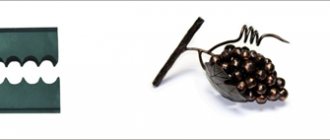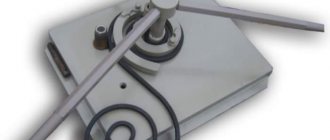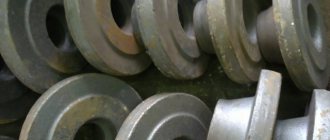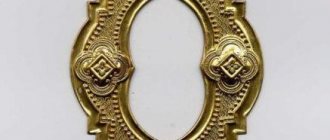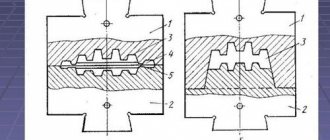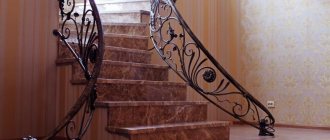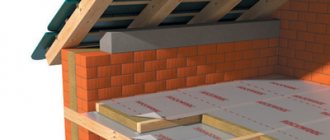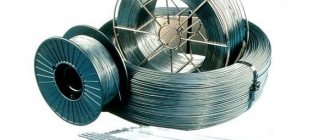According to technical terminology, artistic forging is a method of metal processing in which the required shapes and sizes are achieved through deformation. This definition hides one of the most ancient technologies, which allowed man to take a huge step in history and has not lost its significance today. Forging is actively used in metallurgy and mechanical engineering.
Handmade rose
What is artistic forging
Artistic forging is a special technology for manufacturing household and decorative metal products. It is used to decorate entrance doors, gates, furniture, lamps and other home furnishings. A distinctive feature of artistic forging: the presence of decorative elements. These include silhouettes of animals, birds, plants and complex patterns. Despite the high cost, unique metal products have remained popular for several centuries. Forging masters can make a real work of art.
Hot and cold forging are used for artistic metal processing. Metal processing technology is no different from conventional forging, but requires more delicate work.
These are the masterpieces you get when a real master does forging
Forging in various styles
Among a large list of artistic forging styles, the customer can independently or with the help of a craftsman choose the desired direction. You need to start from the features of the landscape, interior design or exterior of the house. And also your own preferences. First you need to familiarize yourself with the features and differences of forging styles.
Vanguard
The forging style originated at the turn of the 19th and 20th centuries. At that time, excessive bourgeois luxury was rejected, so the avant-garde, which personified mass culture, was popular. Functionality played an important role in the compositions of the style.
Peculiarities:
- transition from luxury to simplicity and practicality;
- rigor and geometric contrast;
- non-standard and functionality.
The style, which rejects stereotypes, has an original vision of space. There are almost no standard forms; a combination of curls that are opposite in perception and strict broken lines is encouraged.
English
The style, also called Victorian, conveys the spirit of English high society. Unlike Avant-garde, there are aristocratic notes here.
Distinctive features:
- interweaving of strict elements and elegant details;
- combination of elegant and simple forms;
- inclusion of wood fragments.
Artistic forging for interior and exterior is distinguished by grandeur and pomp. Strict lines look spectacular and elegant. In the forged elements, in addition to the peaks, there are lions, coats of arms and royal regalia.
Art Deco
France is considered the birthplace of the style, the date of birth of which is recognized as 1925. Art Deco combines modernism and neoclassicism. Gates, canopies, stairs, balcony railings and interior items are usually created in this style.
Individual qualities:
- smoothed corners and vertical lines;
- ovals, rectangles, 3-gons and other geometric shapes;
- decorative elements.
Important: The essence of Art Deco forging lies in numerous curls that are connected to each other by broken lines. Forged compositions combine wood, marble and glass with artificially aged metal in a non-trivial way.
Baroque
The style originated during the Late Renaissance in Italy. Forged products complement the architecture of the house well, bringing grandeur and high status to it. Floral elements in furniture pieces will complement the appearance of the interior.
Peculiarities:
- luxury, grace, pomp and chic;
- many complicated ornaments and patterns;
- an abundance of artistic techniques: volutes, curls, spirals and baskets.
Baroque is characterized by majestic and magnificent forms. The compositions are replete with a variety of decorative details.
Oriental
Eastern style is significantly different from Western. Looking at the compositions, a person finds himself in an amazing fairy tale. In forged works, the luxury of sheikhs is intertwined with a philosophical worldview.
Distinctive features:
- accented ornaments;
- oriental notes in compositions;
- streamlined shapes.
Artistic forging for interior and exterior in the oriental style is distinguished by a combination of elements of different shapes. The compositions may simultaneously contain light smooth lines, closed details, as well as leaves, flowers, and oriental patterns.
Gothic
The style appeared at the end of the 12th century in France and quickly spread throughout Western Europe. Gothic window grilles, furniture, and interior items can often be seen in the design of homestead landscapes and country houses.
Individual qualities:
- geometric patterns, trefoils, finials;
- the ascending aspiration of the elements;
- a combination of airiness and majesty.
Gothic style is dominated by natural ornaments. Oak leaves, flowers, arrow-shaped elements organically intersect with geometric shapes.
Greek
In ancient Greece, blacksmiths were famous for their skills. At that time, mainly military armor was created. Nowadays, artistic forging based on Greek ethnics is popular, which fits well into any interior.
Peculiarities:
- meander pattern, recognizable by broken lines at 90°;
- wavy continuous line;
- monograms with round and rectangular contours.
Forged products are dominated by massive and monumental details. The style is distinguished by the presence of meanders in the compositions, many volutes, and smooth rounded lines. Particular emphasis is placed on floral festoons.
Chinese
Modern Chinese style has been created over centuries. It is based on a philosophical worldview and a measured way of life.
Distinctive features:
- harmony and tranquility;
- soft contours;
- smoothed corners and smooth transitions.
There is no harshness in Chinese style. The compositions are characterized by smooth lines and patterns with rounded corners. Most details have wavy contours and soft transitions.
Classical
The blacksmith's products borrowed ancient Roman minimalism and austerity of elements. Characteristic features of classicism are the alternation of vertical and horizontal lines in symmetrical compositions.
Individual qualities:
- restraint, conciseness and symmetry of forms;
- harmonious combination of details;
- the predominance of spears, curls and vines in the compositions.
The classics are peaks, rectangles, meanders, relief lines and rounded rosettes. In artistic forging there is always laconicism, clarity and contour graphics.
Loft
Loft originated in the forties of the 20th century in the USA. At that time, production was transferred to the outskirts, as a result, many workshops were left empty inside the cities. Designers began to design them in an industrial style.
Peculiarities:
- urban mood;
- brutality of structures;
- minimalism and progressiveness.
The loft is characterized by industrial notes and artistic brutality. Forged interior items lack any manifestations of glamor and pathos.
Modern
At the beginning of the 20th century, concreteness and conciseness disappeared in the design of artistic forging. The emerging style, which became more complex, was perceived at that time as a curiosity.
Distinctive features:
- stylistic diversity;
- harmonious combination of asymmetrical elements;
- loop-shaped stem of cyclamen.
Modern designs have no corners; they have rounded asymmetrical contours. Forged compositions include motifs from the natural world. Preference is given to exotic cyclamens, orchids and irises.
Renaissance
The style, which appeared in the 14th century in Italy, had a positive impact on the cultural development of mankind. At that time, cities were developing and prosperity was growing. New trends began in artistic forging - flat strips and square rods began to be used.
Individual qualities:
- clear symmetrical lines;
- accented center of the composition;
- antique motifs combined with spirals and figure eights.
Important: Products of Renaissance artistic forging embody weightless lightness. Frameless compositions combine original shapes with graceful weaves. The development of each plot begins from the center.
Russian
Blacksmithing was revered back in the days of Kievan Rus. Then even the exterior of a simple hut was decorated with forged items. Locks, dishes, household utensils, and tools were made from metal.
Peculiarities:
- numerous convex shapes;
- inclusion of Russian traditions;
- compositions based on local vegetation.
Since the Russian style of artistic forging is too heavy for interior design, it is mainly used in landscape design. The designs are dominated by monograms, curls, convex and volumetric details.
High tech
High-tech is an ultra-modern style that began in the 60s. It is characterized by constructiveness, functionality, and manufacturability. When using it, the space is not loaded, there are no unnecessary details.
Distinctive features:
- rigor and simplicity of forms;
- use of modern materials and high technologies;
- symbolization of progress.
The distinctive features of high-tech are a maximum of straight lines and strict geometric shapes, a minimum of frills. Forged compositions go well with glass.
Metal processing stages
- Heat treatment of materials. This is a preliminary stage of work, during which the metal is heated to the desired temperature. Heating occurs in a forge or induction furnace. Heating time depends on the type of metal. The heat treatment process also includes cooling, tempering and hardening of the metal.
- Forging. The process of manufacturing parts. During forging, the master gives the material the desired shape using various techniques. The process of heat treatment and forging can be repeated many times, since the workpiece quickly cools and loses the temperature necessary for operation.
- Assembly. During the assembly process, parts are connected to each other into a single product. The simplest type of assembly is welding. At the welding site, the parts are heated and connected to each other: the heated metal instantly adheres and hardens. Assembly using rivets and clamps is also possible.
- Decoration. In simple forging, the blacksmith completes the work by polishing the product, giving its surface reflective properties and the desired texture. In artistic forging, additional techniques can be used: etching and embossing. Etching is the application of chemicals to the surface of a product that react with the metal and give it its original color. Embossing - applying an ornament using.
The mission of a professional blacksmith
“Art Forge” demonstrates an unusual approach to organizing a blacksmith’s manufactory, relying not on market demand, but on offering exclusives and complex handicrafts that have not only practical, but also artistic value. Creating your own style and the absence of boundaries in creative search allow you to work with different materials, harmoniously combining stone and wood into unique ensembles with a steel frame. In addition, the maestro’s designs also use other compositions that are not typical for hot-forged compositions, such as leather and fabric. Despite the difference in their properties and visual qualities, they are well intertwined into a single symphony.
The latest construction innovations provide advantages in the construction of gray, impersonal boxes of glass and concrete in huge volumes, providing tens and hundreds of thousands of new residents with millions of square meters of residential and commercial space. This is wonderful, but there is an alternative, which lies in magnificent works, the birth of aesthetically perfect combinations of metal, wood, stone and glass parts.
The implementation of such projects is our fundamental idea, and the desire to recreate masterpieces was an important driver for the entire team.
Techniques for hot metal processing
To give metal parts the desired shape, the master uses various processing options:
- planting is a technique that allows you to obtain protrusions: dense thickenings of various sizes, which in further work can be shaped into leaves or petals;
- broaching – lengthening the original workpiece and reducing its cross-section; using crimping, you can increase the length of the workpiece several times and strengthen the metal;
- rounding - helps to round the corners of a square workpiece; To do this, the part is laid on an edge, and blows are applied to the opposite edge with a hammer: the workpiece takes the shape of an octagon and is gradually rounded;
- threading - hand forging involves creating products that imitate weaving (threading rods through each other); to do this, a hole is punched in one of the rods and the other is threaded through it;
- design of ledges - ledges are the flat ends of the workpiece, which help connect the parts; they are created by processing the part on an anvil;
- bending - with its help you can create a twisted part: a spiral, a curl, a loop; For bending, a special tool is used - a fork, with which the desired shape is formed.
In artistic forging, punching can also be used: creating holes to form a pattern or connect parts. But thanks to modern technologies, punching is often replaced by drilling.
Working with metal in a forge is difficult and dangerous - injuries and fires are possible
DIY forged elements and parts
Today there are shops or workshops offering art products of their own production. The demand for these products is stable, despite the inflated cost of forged products.
If you wish and have some experience working with metal, you can do much of what professionals can do with your own hands. It is not at all necessary to arm yourself with a forge and a sledgehammer or purchase a special machine. Even for the manufacture of complex elements or products, a workbench, a vice, a welding machine and a hammer are sufficient. The material for amateur creativity will be a round rod, a profile pipe with a small cross-section, a narrow strip of steel or sheet metal.
Metal bending (Photo: pixabay.com)
Furniture
As furniture for self-production, you can consider garden or country tables and chairs, decorative shelves for walls. Forged elements can decorate the interior of a kitchen, bedroom, hallway or garden gazebo, and an old stool or floor lamp intended for scrapping can be reinforced with forged strips and presented as an antique.
Alcove
A gazebo is the cherished dream of summer residents and owners of their own plots; it does not have to be made of wood or brick. You can also make a metal structure from a profile. It is easy to turn it into a light and elegant composition with the help of hand-made forged parts - an openwork arch twisted from a steel circle at the entrance, curlicues around the perimeter of the gazebo or an intricate pendant for a lamp.
Gates
Forged gates and entrance gates are perhaps the most popular products from the range of artistic forging today, in which practicality is combined with artistic taste. Meanwhile, many owners of private houses, for economic reasons, make do with an entrance unit purchased or independently made from standard rolled metal and metal profiles.
Any metal structure can be classified as non-standard or made initially using the simplest self-made forged elements. The already mentioned steel rods, profiles or strips are used as a workpiece. From them you can make various twisted patterns and monograms, leaves and buds, strict or arbitrary geometric shapes.
Cold forging: limited elements and variety of products
The cold forging method, according to historians, first appeared in Mesopotamia and Egypt about 6 years ago. It does not require much knowledge or special tools. Essentially, cold forging is the bending of rods. Therefore, it is mainly used to create trellises, fences, fences, gates, gates, stairs and railings.
The most difficult thing in cold forging is connecting the rods using a welding machine. And the work itself on changing the shape of iron rods can be carried out both on homemade devices (bent, snail, wave and globe), and on professional machines. One of the most popular machines for cold forging is Azhur-Mini from the Azhurstal plant.
The advantage of cold forging is that you can make the tools yourself. Unless you have to buy a relay
Using the cold forging method, you can:
- bend;
- flatten;
- twist.
Its advantages include:
- lack of special skills for work;
- the ability to carry out operations on inexpensive or self-made devices;
- high level of productivity;
- the possibility of various combinations of basic elements and creating a huge number of unique products from them.
Disadvantages of the method:
- small selection of operations;
- a limited set of initial elements (rolled profiles, metal strip, solid and square rods).
Renaissance style
The Renaissance era (from the French “renaissance” - rebirth) is a rethinking of ancient art, a kind of return to it. It was a real breakthrough with fresh, strong ideas in all areas of culture. Of course, the art of forging was no exception. In forging, such innovations were born as a round rod, and from it magnificent spirals and branches with luxurious flowers and leaves at the end, as well as a method of threading rods in “figure eights”. The result is a light, elegant, but durable lattice. The main decorative elements were spirals, braids, leaves, and volutes returned to use.
Main features of the style:
* Antique motifs
* Harmony, proportionality of details
* Round rod
* “Eights”, spirals, braids are typical elements
Artistic forging styles
| Renaissance | Forging in the Renaissance style | Forging styles |
Types of artistic forging
There are two types of forging: free and die. A stamp is a special blank that sets the shape of a future product. The walls of the die prevent the heated mass of metal from spreading and deforming. Stamping is a simpler, almost automatic type of forging, which is often used in mass production. It allows you to produce many products of the same shape in a short period of time. For individual orders, free forging is used.
In open forging, the material is processed in two ways: manually and using equipment. This process requires professionalism and a high degree of concentration. The main tools of a craftsman for hand forging are a hammer and a sledgehammer. Machine forging is performed on a forging machine using a hammer and a hydraulic press. When heated, the crystals are destroyed, the metal structure becomes fine-grained and compacted.
Most studios, salons and workshops produce custom products. This allows you to supplement the sketch with the necessary elements and get a sofa or staircase that suits your interior. And the quality of exclusive products is higher than those sold in stores.
Exclusive, custom-made forged roses. You can’t buy products of this quality in a regular store.
Technological processes
To create a quality product, it is necessary to adhere to certain technological processes. Absolutely all blacksmiths use them. Conventionally, they are divided into the following types:
- Bending is one of the most common operations. To create an arcuate bend, the workpiece is preheated. Then, they place the anvil on the horn and bend the product.
- Drawing is done on an anvil, by hitting a heated workpiece with a sledgehammer. This operation allows you to reduce the cross-section and stretch the product.
- Cutting patterns - is done by applying silhouettes, lines, strokes and fonts with a chisel on a preheated workpiece.
- Assembly is carried out using forge welding or riveting. This is the final process. At this stage, all individual elements are assembled into the finished product.
To extend the life of a forged product, it is important to paint it. The metal is pre-treated with a primer, this will preserve the anti-corrosion properties of the paint. It is better to apply the coating in two layers.
Metals used
For artistic forging, pure metals and various types of alloys are used. These include:
- Bronze. This is an artificially created material made from an alloy of copper and tin. Bronze is hard, but malleable when processed; its structure allows it to imitate other metals.
- Brass. Yellow metal, looks like gold. It is made by combining copper and zinc. Brass can be varnished, painted, or given any texture.
- Copper. Basically, roofs and hoods are made from this material. Copper has a beautiful red-brown color and can be given different shades by polishing. Decorative copper items such as cups, frames and ornaments are also popular.
- Cast iron. It is made from an alloy of iron and carbon. Massive products are made from it: fences, spiral staircases. Cast iron is a malleable material, it can be covered with a patina and get any desired color: from black to golden.
- Steel. This is a universal material from which you can make any product, including a sewing needle. To produce steel, iron is combined with carbon - the resulting alloy is soft and ductile when heated, and becomes strong when solidified.
- Blued steel. To obtain this material, steel is dipped in oil and fired. During the cooling process, a protective film is formed that protects the metal from corrosion. From blued steel you can make thin lace products: carved shutters and fences.
- Stainless steel. It is created by combining iron with chromium, nickel and titanium. Stainless steel is a durable material that is difficult to texture. Most often it is sanded and lightly polished to achieve a matte finish.
- Zinc. When polished it gives a wide variety of shades. Suitable for massive outdoor products.
- Titanium. It has a noble dark shade and good reflectivity. Titanium furniture is ideal for modern high-tech style.
- Zinkotitan. A material that requires patience: it is difficult to machine, but chemical etching can produce beautiful textures.
- Gold. A very soft and pliable material, famous for its high cost. Miniature products are made from gold, most often jewelry. Gold plating is also popular: a product made of cheaper metal is covered with a thin gold film on top.
- Silver. Metal with the highest reflective properties. In ancient times, mirrors were made from silver; for modern decor, silver frames, trays, cups, and furniture trim are often ordered.
Regardless of the type of metal chosen, a product created by artistic forging will look beautiful and expensive. Metal interior details emphasize the status of the owner of the home and create a unique atmosphere.
Table made of bronze. Every detail is forged with love
Classicism
Classicism (from the Latin word “classicus” - which means “exemplary”) is a style of magnificent artistic art, also striving for ancient examples, the time of the Enlightenment, a style that replaced the baroque decorativeness and frivolity of Rococo with a new spirit of laconicism and rigor. Forging is dominated by clear, harmonious forms, the integrity of the composition, and its balance. The fences use rods with spear-shaped tops. The decoration includes a meander (the famous antique ornament in the form of a broken line), as well as reliefs and various other patterns - vines, wreaths, spears.
Main features of the style:
* Laconicism, restraint of forms
* Harmony, balance of composition
* Symmetry
* Meander, vines, wreaths, flowers, spears, reliefs are typical elements
| classicism | bed | Fencing, forging styles |
| gates | forging | classic balcony |
| gates | classic fence |
Application options
The most popular metal product: forged gates and fences. Massive or patterned, made of pure metal or alloy - they look equally sophisticated and elegant. But forged products are not just interior decoration. Metal shutters, stair railings, decorative gates and balconies are able to withstand high loads, sudden temperature changes and exposure to the elements.
Non-functional forms of interior elements include rotundas, fences for flower beds, figurines of plants and animals. They will decorate any garden and emphasize its individuality.
The ability to give a product any shape allows you to create designs of any complexity - thanks to this, artistic forging remains the most popular way of decorating a home.
A gate made in the shape of a dragon will attract the attention of guests and arouse the envy of neighbors
Gothic style
Gothic (from Italian “gotico” - barbaric) style was born in the Middle Ages. Having supplanted the Romanesque style, it became a completely new and very unusual phenomenon in art. Gothic style is characterized by upward movement, sharp peaks and finials, and strict geometricity. Forged products of the Gothic style are intimidatingly majestic, they are characterized by spikes and a general sharpness of lines. Fences with arrows, narrow gaps between the rods, the rods themselves - of a complex profile - often form perforations (a connection when one rod passes through another), ornaments in which floral patterns dominate - rosettes, lilies, cruciferous flowers, trefoils.
Main features of the style:
* Majesty
* General upward direction
* Sharp pommels
* Rosettes, lilies, cruciferous flowers, shamrocks are typical elements
Gothic style
Gothic, forging style
| Gothic | gothic railing style |
| Artistic forging styles, balcony | Gothic benches |
Interesting Facts
The peak of development of artistic forging as a separate art occurred in the 6th-8th centuries AD. To become a master, future blacksmiths began training in early childhood. At first, the apprentice only observed and helped the blacksmith: he handed over tools, looked after the stove, brought water and firewood. Gradually, the student was allowed to do simple work: preparing metal and forging small, simple elements. After 5-6 years of training, the young blacksmith was already able to independently produce various types of products: from door handles to forged swing gates.
The entire forging process was done by hand. An experienced craftsman could determine the type of metal by examining the breakdown of the product and the type of spark produced. The temperature was also determined by its appearance: focusing on the color of the red-hot part, the master accurately determined at what moment it warmed up to the required temperature.
Forged products made to order were especially popular. During the period from the 13th to the 15th century AD. e. Rich nobles loved to decorate their estates with forged fences, gates, window bars and various interior items. Many products have survived to this day and are a cultural achievement of the nation.
Hephaestus - ancient Greek god of fire and blacksmithing
Baroque
Baroque (from the Italian word “barocco” - strange, pretentious) also belongs to the artistic styles of the Renaissance, but its main difference is its non-compliance with the rules of harmony and emotionality. Baroque is sensual, replete with strange, intricate patterns and sometimes very complex shapes. This is a pomp, an exciting abundance of detail. In forging, the same spirals, braids, volutes and other elements in the Baroque style merge into a single design that amazes the eye with luxury, in which one is inseparable from the other. The most commonly used element in the Baroque was the curl.
Main features of the style:
* Splendor, sensuality of forms
* Abundance of elements, intricacy of patterns
* Grace
* Curl is a typical element
Baroque in forging
| baroque bed | baroque forging style |
| baroque balcony | forged furniture, baroque |
| baroque gate | artistic forging style |
Photo galleries
Gates and wickets
A family monogram on the gate will turn an ordinary house into a family nest
Gates made according to the client's sketch. Simple but tasteful
Beautiful gates can be made for a garage
Beauty is in every detail - that’s why artistic forging is so popular
Simple elements create a beautiful composition
Firebird on the gate - Russian fairy tales in the modern world
Fences and railings
Beauty is in simplicity. Behind such a fence can hide both a village hut and a three-story cottage
The stone pedestal and the fence, as if “grown” into it, create a single composition
Iron roses are in no way inferior in beauty to the tulips growing nearby. A professional blacksmith can breathe life into soulless metal!
It seems like an unremarkable fence. But even she is beautiful in some way
Interweaving of leaves and flower buds. The master did a great job
Thin branches, as if alive, entwine the fence. The composition seems fragile, but will last for centuries
Stairs and railings
Amazing beauty! Correctly selected colors create the impression of a play of light and shadow
Few people will notice a flower with four petals here, but everyone will appreciate the beauty of the pattern.
The staircase and chandelier were created by the same blacksmith and therefore fit perfectly together
Patterns, lines, flowers. Simple, elegant and beautiful
A very unusual pattern. Fancy forged railing elements
A wrought iron staircase complements the interior. And it seems that she and the chair are one whole. Here the work of the designer is no less important than the quality of forging
Rococo
Rococo (from the French “rococo”, originally “rocaille” - crushed stone, decorative shell, shell) was based on decorativeness, moreover, playful and frivolous, which completely rejected the severity of lines that was still present in the Baroque. Rococo forging is distinguished by its subtlety, elegance and lightness, asymmetrical fractional patterns of ornaments with filigree S- and C-shaped curls that fill all the free space.
Main features of the style:
* The primacy of decorativeness
* Frivolous, playful forms
* Graceful lines
* Fractional and asymmetrical patterns
| Rococo in forging | Forging, styles |
| Artistic forging styles | rococo bed |
| Gazebos, forging style | Rococo railings |
| style features | Rococo grilles |
| gate in rococo style |
Equipment for home blacksmith shop
Do-it-yourself artistic forging is impossible without the presence of special equipment. To do this, a novice master must first acquire a bender.
Gnutik
It helps to bend products at the desired angle or arc of the desired radius.
Optional equipment:
- A flashlight is the most difficult tool. This device allows you to create not each part separately, but several at once from single rods. The tool helps to make baskets of different sections and diameters from iron rods.
- Snail – helps create spirals from prepared elements. Spiral-shaped monograms are often found on forged products. Therefore, a novice craftsman can make his own snails of various diameters.
- Twister - helps to weave rods around the longitudinal axis. The operating principle of this device is very similar to a flashlight. This tool allows you to create three-dimensional parts and braiding to decorate the finished product.
It is also important to have a variety of vices, hammers, and sledgehammers in the blacksmith’s arsenal. It would be useful to purchase a grinder, a welding machine, a cutting and sharpening machine.

